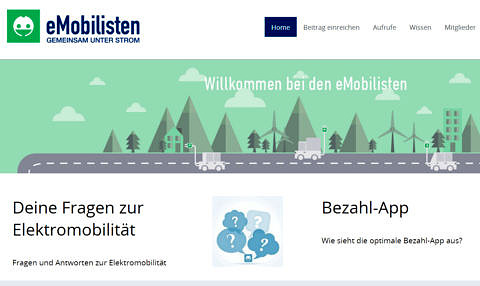Generating enthusiasm for electromobility
FAU researchers launch online platform to increase the acceptance of electromobility
Where can I charge my electric car? How exactly does it work? And how long does it take? When it comes to electromobility, there is widespread uncertainty and a lack of knowledge among a large proportion of the general public. This leads to a lack of acceptance – and not very many electric cars on Germany’s roads. Researchers at FAU have now launched the online platform www.emobilisten.de in an effort to provide the public with information and convince them of the benefits of this type of mobility by developing new solutions together.
The German government’s target is to have one million electric cars on Germany’s roads by 2020. This is an ambitious goal considering that the current number is only around 20,000. The technology itself is not the main reason that electromobility has yet to become more widespread. The problem is the lack of acceptance among the general public. ‘When we consider potential users, there is still a lack of knowledge and experience, as well as acceptance problems,’ explains Prof. Kathrin M. Möslein, Chair of Information Systems I – Innovation and Value Creation.
Anyone can share their knowledge
To help increase the acceptance of electromobility in society, researchers at FAU have launched the online platform www.emobilisten.de as part of the CODIFeY project. The platform has two main purposes. Firstly, it provides information on various aspects of electromobility – with the help of people who use electric cars or are interested in them. Anyone can offer a course on the knowledge platform, allowing them to share their knowledge of electromobility with other users. ‘Our aim is to provide the missing information and clear up unanswered questions. Everyone is invited to share their knowledge. In this way, we want to change people’s ideas about sustainable mobility,’ says Prof. Dr. Markus Beckmann from the Chair of Corporate Sustainability Management. ‘Finding the right methods of communication is a particular challenge here,’ explains Prof. Dr. Andreas Fürst from the Chair of Marketing.
What should the ideal e-mobility app look like?
The second key idea is to encourage people to get involved on the website. Each month researchers present a topic with high potential for improvement for discussion. The current discussion is on electromobility apps, in particular payment apps.
After initial ideas have been suggested, particularly active users will be invited to take part in a workshop and the resulting discussion will be used to develop the ideal electromobility app. The results of the workshop will then be made available for everyone online. ‘Members of the public who are interested are invited to participate and put forward their ideas and expectations. In this way, people’s needs with regard to e-mobility will be taken into account,’ explains Christofer Daiberl, a research assistant at the Chair of Information Systems I – Innovation and Value Creation. ‘We hope that people will become more open to electromobility as they have the opportunity to get involved. This is a key part of the strategy for increasing the use of this promising form of mobility.’
The CODIFeY project
The emobilsten.de initiative was launched as part of the joint project CODIFeY. In addition to those from FAU, researchers at Technische Universität Chemnitz and the Fraunhofer Center for Applied Research on Supply Chain Services (SCS) are also involved in the project. The project’s industrial partners are ENERGIEregion Nürnberg e.V., chemmedia AG and HYVE Innovation Community GmbH. The researchers are also working with ADAC Nord-Bayern e.V., Energie Campus Nürnberg, Erlanger Stadtwerke AG, infra fürth, the city of Nuremberg and Bundesverband CarSharing e.V.
More information is available at www.emobilisten.de and facebook.com/gemeinsamunterstrom.
Further information:
Christofer Daiberl
Phone: +49 911 5302882
christofer.daiberl@fau.de
